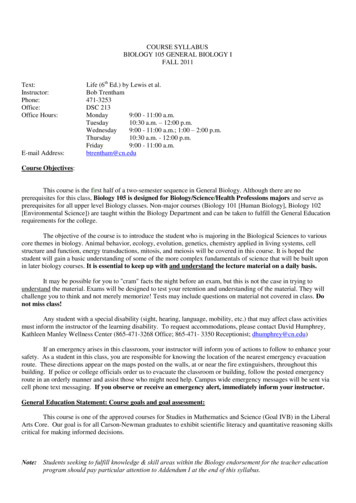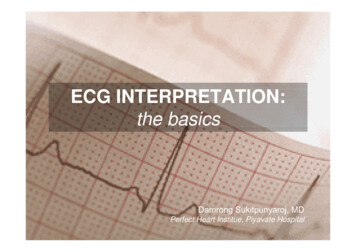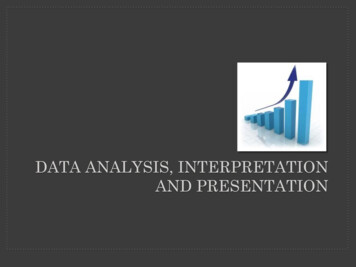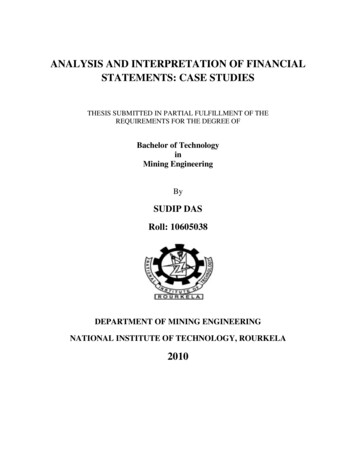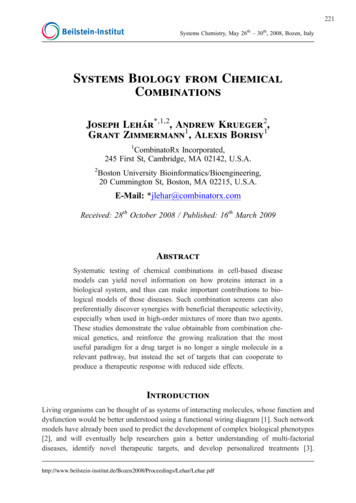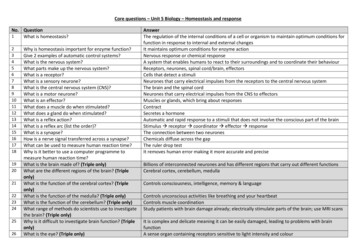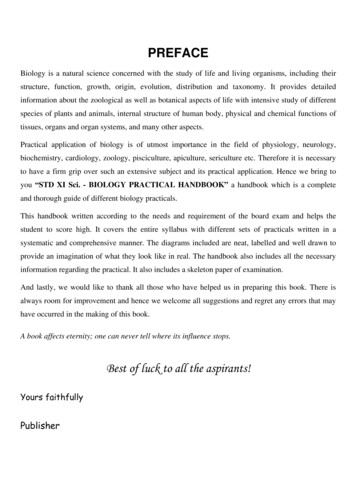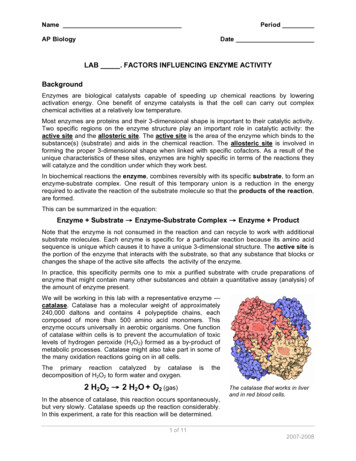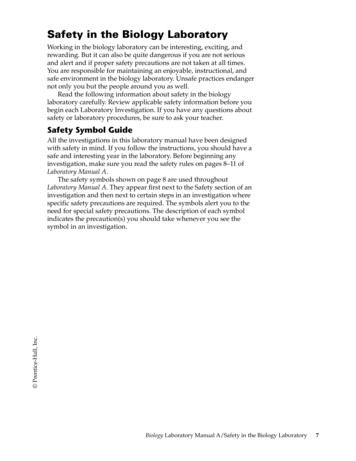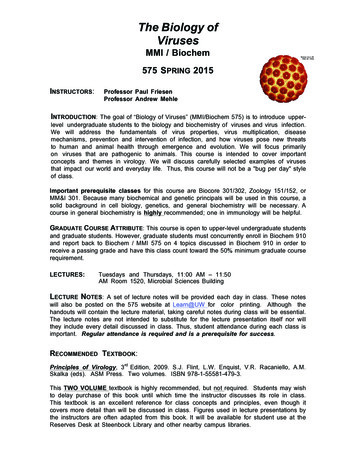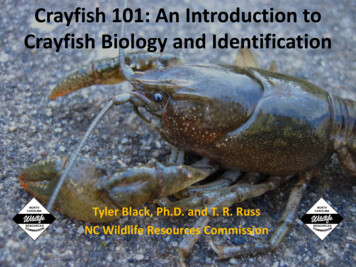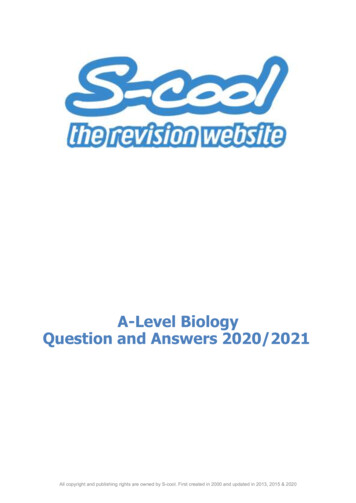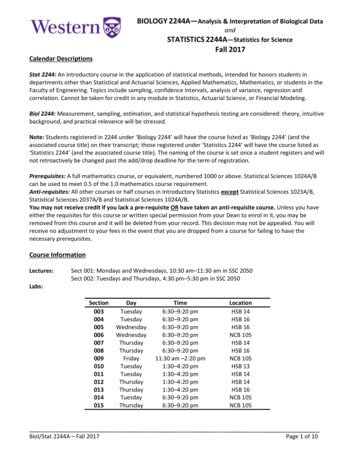
Transcription
BIOLOGY 2244A—Analysis & Interpretation of Biological DataandSTATISTICS 2244A—Statistics for ScienceFall 2017Calendar DescriptionsStat 2244: An introductory course in the application of statistical methods, intended for honors students indepartments other than Statistical and Actuarial Sciences, Applied Mathematics, Mathematics, or students in theFaculty of Engineering. Topics include sampling, confidence intervals, analysis of variance, regression andcorrelation. Cannot be taken for credit in any module in Statistics, Actuarial Science, or Financial Modeling.Biol 2244: Measurement, sampling, estimation, and statistical hypothesis testing are considered: theory, intuitivebackground, and practical relevance will be stressed.Note: Students registered in 2244 under ‘Biology 2244’ will have the course listed as ‘Biology 2244’ (and theassociated course title) on their transcript; those registered under ‘Statistics 2244’ will have the course listed as‘Statistics 2244’ (and the associated course title). The naming of the course is set once a student registers and willnot retroactively be changed past the add/drop deadline for the term of registration.Prerequisites: A full mathematics course, or equivalent, numbered 1000 or above. Statistical Sciences 1024A/Bcan be used to meet 0.5 of the 1.0 mathematics course requirement.Anti-requisites: All other courses or half courses in Introductory Statistics except Statistical Sciences 1023A/B,Statistical Sciences 2037A/B and Statistical Sciences 1024A/B.You may not receive credit if you lack a pre-requisite OR have taken an anti-requisite course. Unless you haveeither the requisites for this course or written special permission from your Dean to enrol in it, you may beremoved from this course and it will be deleted from your record. This decision may not be appealed. You willreceive no adjustment to your fees in the event that you are dropped from a course for failing to have thenecessary prerequisites.Course InformationLectures:Sect 001: Mondays and Wednesdays, 10:30 am–11:30 am in SSC 2050Sect 002: Tuesdays and Thursdays, 4:30 pm–5:30 pm in SSC 14015Biol/Stat 2244A – Fall ursdayTime6:30–9:20 pm6:30–9:20 pm6:30–9:20 pm6:30–9:20 pm6:30–9:20 pm6:30–9:20 pm11:30 am –2:20 pm1:30–4:20 pm1:30–4:20 pm1:30–4:20 pm1:30–4:20 pm6:30–9:20 pm6:30–9:20 pmLocationHSB 14HSB 16HSB 16NCB 105HSB 14HSB 16NCB 105HSB 13HSB 14HSB 14HSB 16NCB 105NCB 105Page 1 of 10
Instructor ennifer WaughBiology and Statistical & Actuarial SciencesMondays, 12:00 noon–2:00 pm in NCB 301LThursdays, 9:30 am–11:30 am in NCB 301LUse OWL messages only (contact ‘Instructor Role’) - not UWO email*Any additional help sessions or drop-in hours before tests/exams, as well as any change to regular drop-in hours (these mayneed to be rescheduled from time to time), will be posted to OWL announcements. Please note that individual appointmentswill not be scheduled outside drop-in hours unless you have direct timetable conflicts with both time periods in their entirety.Communicating with the InstructorUse the OWL Messages (to ‘Instructor Role’) tool when asking a personal administrative question (i.e. confidentialquestions about marks, participation, progress, absences, etc.) that requires a brief response; course contentrelated questions or non-personal questions should be posted to the 2244 OWL Forums. You can expect aresponse to an OWL message to the instructor or a posting to the Forum within 48 hours during the work week(during busy times, it may take a little longer). Note that Messages or Forum questions will not be answeredwithin the 24-hour period before the tests or exams, nor can I guarantee responses over weekends/holidays. This‘black-out’ period is not meant to be punitive; it is meant to encourage students to be proactive in seeking helpand preparing for assessments.Students are responsible for checking OWL (http://owl.uwo.ca) on a regular basis for news and updates. This isthe primary method by which information will be disseminated to all students in the class.Course ObjectivesBy the end of this course, it is my hope that you will have the ability to: Recognize, select, and evaluate different data collection procedures (i.e. sampling and study designs), Select, calculate, interpret, and critically evaluate numerical and graphical summaries of data, Identify, conduct, interpret, and critically evaluate statistical inference procedures, Use statistical software (R and R Studio) to summarize, interpret, analyze, and communicate data, Critically evaluate, and properly communicate statistical information, Apply concepts learned in this course to future courses, careers, and everyday life.Required MaterialsBaldi, B. and DS. Moore. 2013. The Practice of Statistics in the Life Sciences. 3rd Edition, W.H. Freeman andCompany.The textbook is available at the UWO bookstore in ebook (i.e. 12-month subscription to online, 2244-customizedresources, including an electronic copy of the textbook as the ‘Launchpad Etext Access Code for Practice ofStatistics’) and printed options (hardcover or binder formats). I “require” the ebook version because I havecollected assigned readings into Preparation reading ‘units’ to prepare you for lectures (printed versions can’t bemanually organized this way). You will have quizzes based on these units (see more information aboutpreparation quizzes below). One of the other benefits of using the ebook is that it shows instructor annotationsdirectly on the text pages; these annotations provide clarification of common issues in the textbook/withstatistics, identify sections that can be skipped, or highlight content that we do differently in the course. Notethat, if you prefer to purchase a printed book, a Launchpad access code is automatically included from theBookstore. Several copies of the printed textbook are also available on 1-day reserve in Taylor library.Biol/Stat 2244A – Fall 2017Page 2 of 10
Important Information1. If you would like to make an audio recording of the lectures/tutorials in this course, you MUST askpermission first (through OWL Messages sent to ‘Instructor Role’). According to intellectual propertylaws, not asking permission constitutes stealing. I will NOT permit videotaping lectures under anycircumstances.2. Course material (i.e. lecture slides, videos, quizzes, practice, and actual exam questions and othersupplementary material posted on OWL) is the intellectual property of your instructor and is madeavailable to you for your personal use in this course. Sharing, posting, selling, or using this materialoutside of your personal use in this course is considered an infringement of intellectual property rights.Outline lecture slides will be posted in .pdf format, 1 slide per page only, no later than 11:59 pm the nightbefore lecture. Alternative file formats will not be available. Note that complete PowerPoint slides usedin class will NOT be posted or distributed in any form under any circumstances.3. The Forum tool is enabled on the OWL website. Please use this Forum to post and respond to questionsabout course content (e.g., lecture, readings, practice questions, etc). The Forum will be monitored on aregular basis and the instructor will interject with corrections or responses as necessary. As this is an openForum, please be respectful of your peers, instructor(s), and TAs. Derogatory, discriminatory, or otherwiseinappropriate language or topics will be removed and dealt with at the instructor’s discretion.Assessment and EvaluationYour final grade will automatically be calculated to give you the highest mark possible based on the following twograde breakdowns, based on whether clicker participation is incorporated or not:Course ComponentCourse Structure QuizClicker ParticipationPreparation QuizzesOnline Assessment5 Lab AssignmentsWith Clickers1%5%5%3%17% totalWithout Clickers1%0%5%3%22% total5%4% each2% each1% bonus6%5% each3% each1% bonusHighest lab2nd & 3rd highest labs4th & 5th highest labsPreparation labDeadlines/Due DatesAvailable online Sept. 7 to Sept. 18 (at 11:59 pm)During lecture, starting Sept 13/14Watch for deadlines on OWLAvailable online Oct. 31 – Nov. 1 (at 11:59 pm)Starting the week of September 18;see course schedule (last page) for lab weeksNo Risk Test 1*10%10%Friday, Oct 20th, 7:00 - 8:00 pmNo Risk Test 2*14%14%Saturday, November 18th, 10:00 am - 11:30 amFinal Exam*45%45%During December exam period (Dec 10-21)*see information below regarding the ‘No Risk’ aspect and weightings of Tests 1 and 2, and the Final Exam.Course Structure Quiz: A quiz administered through OWL Test & Quizzes, assessing understanding of coursepolicies and structure as described in this course syllabus and the OWL course website. More detailed informationabout structure and content of this quiz is provided on the course website. No accommodation will be made afterthe deadline for any reason (e.g., technical problems or late registration in the course); attempt the quiz earlyduring the availability period so that any problems that arise can be dealt with before the deadline.Clicker Participation: Clickers will be used in every lecture. For your clicker participation to be counted, you mustreview the information on OWL under Course Materials/Administration/Clicker Registration and Setup to be sureyou have set up, and use your ‘clicker’ properly. There will be ‘trial’ classes at the very start of the term tofamiliarize yourself with using a clicker in 2244.Biol/Stat 2244A – Fall 2017Page 3 of 10
Multiple clicker questions will typically be asked during lecture. The% Questions answered Final Clickerproportion of questions that you answer will determine the fractionMark (/5%)of the available clicker participation grade (5%) that you earn, as00shown in the table at right. Classes may vary in the number of0 % answered 201questions asked; however, in computing final clicker participation20 % answered 402grades, each class will be weighted equally (for example, if you miss a40 %answered 6035-question class, you won’t be missing more toward your clicker60 % answered 804grade than if you missed a 2-question class instead). For a given80 %answered 1005lecture, you can earn credit for answering clicker questions in eitherlecture section (i.e. it doesn’t need to be the section you are officially registered in), but not both (lectures aretypically paired across sections as Mon/Tues and Wed/Thurs).Clicker participation only requires that you try; you do not have to get the questions right to get this part of yourcourse grade. Notice that you can miss up to 20% of the clicker questions for any reason without affecting yourgrade; this ‘buffer’ accounts for any technical/WiFi problems that may arise during the course, as well as days onwhich you forgot your device or had to miss all or part of a lecture. Please note that no accommodation will bemade for missed clicker participation or incorrectly registered clickers. Your clicker participation mark will becalculated based solely on the data in class records.Refer to the “Use of Clickers in this Course” section toward the end of this document for further details aboutClicker use.Preparation Quizzes: Short quizzes administered through OWL Test & Quizzes, assessing understanding ofassigned content from the textbook/LaunchPad and/or material posted to OWL. More detailed information aboutstructure and content of each quiz will be provided on the course website as the quizzes become available. Noaccommodation will be made after the deadline for each quiz for any reason (e.g., technical problems); attempt thequiz early during the availability period so that any problems that arise can be dealt with before the deadline.These quizzes are incorporated into the course to:(i) encourage students to actively complete and engage with the course material on a regular schedule;(ii) review new and previous course concepts that will be drawn upon during upcoming lectures;(iii) provide students with regular feedback on their understanding of fundamental course concepts.These quizzes are not intended to represent the level of difficulty or comprehension involved in labs, tests, or exams;they are testing for foundational knowledge and understanding only.Quizzes are graded for correct answers; a student’s individualPoints collectedFinal Preparationmark on a quiz will equal the number of ‘points’ collected(% total offered)Quiz Mark (/5%)towards the Preparation Quiz mark. At the end of the course, the00total number of ‘points’ a student has accumulated will be tallied,0 % answered 201and expressed as a percentage out of the total number of points20 % answered 402‘offered’ across all quizzes presented during the course (during40 % answered 603previous course offerings, the total points offered across the60 % answered 804term was approximately 40; this term may be slightly more or80 % answered 1005less). This percentage of points collected by the student will beused to determine the student’s final Preparation Quiz mark for the course, using the conversion scheme presentedin the table above.Online Assessment: A short online Assessment administered through the OWL ‘Tests & Quizzes’ tool, assessingunderstanding and application of important course concepts from the beginning of the course. More detailedinformation about structure and content of this Assessment will be provided on the course website. Students willBiol/Stat 2244A – Fall 2017Page 4 of 10
have two (2) attempts at the Assessment (with different questions); consequently, no accommodation will bemade for technical issues, conflicts, etc. and no make ups Assessments will be provided. Students who fail tocomplete the Assessment but do receive academic accommodation from an academic counselor co
Faculty of Engineering. Topics include sampling, confidence intervals, analysis of variance, regression and correlation. Cannot be taken for credit in any module in Statistics, Actuarial Science, or Financial Modeling. Biol 2244: Measurement, sampling, estimation, and statistical hypothesis testing are considered: theory, intuitive
